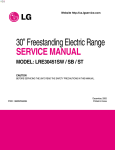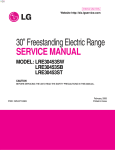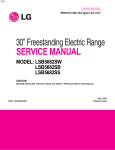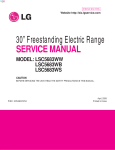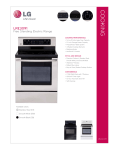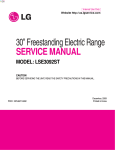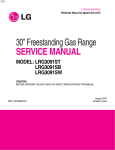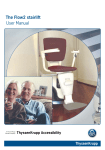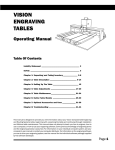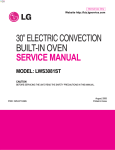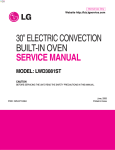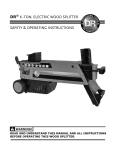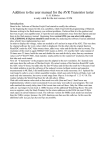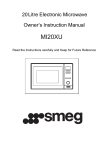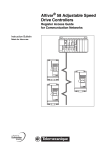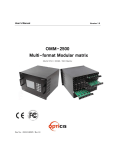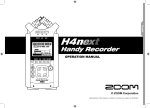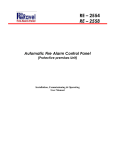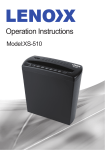Download 30” Freestanding Electric Range SERVICE MANUAL
Transcript
삼 정 흥 판 Internal Use Only Website http://biz.lgservice.com 30” Freestanding Electric Range SERVICE MANUAL MODEL: LRE3091SW LRE3091SB LRE3091ST CAUTION BEFORE SERVICING THE UNIT, READ THE SAFETY PRECAUTIONS IN THIS MANUAL. June, 2009 Printed in Korea P/NO : MFL37118306 1 FORWARD This LG Service Manual, “30” Freestanding Self-Cleaning Electric Range,” provides the technician with information on the operation and service of the Freestanding Self-Cleaning Electric Range. It is to be used as a training Service Manual. For specific information on the model being serviced, refer to the “Owner’s Manual” or “Tech Sheet” provided with the electric range. SAFETY PRECAUTIONS • Repairs of the appliance should be carried out by a licensed technician only. Incorrect repairs may result in dangerous situations. If you need repairs, contact an LG Service Center or your dealer. • If the power cord is defective, it must be replaced by a qualified service agent with a UL listed range cord. • Electrical leads and cables should not be allowed to touch the oven. • Rating plate is located on the left side of warming drawer. • The power supply of the appliance should be turned off when it is being repaired. ! WARNING • DISCONNET power supply cord from the outlet before servicing. • Replace all panels and parts before operating. • RECONNECT all grounding devices. - Failure to do so can result in severe personal injury, death or electrical shock. • DO NOT Touch when the oven operates. - The interior parts will be very hot. LG Electronices assumes no responsibility for any repairs made on our products by anyone other than Authorized Service Technicians. TABLE OF CONTENTS (PAGE) GENERAL- - - - - - - - - - - - - - - - - - - - - - - - - - - - - - - - - - - - - - - - - - - - - - - - - - - - - - - - - - - - - - - - - - - - - - - - - - - - - - - - - - - - - - - - - - - - 1-1 ~ 1-5 • Important safety instructions - - - - - - - - - - - - - - - - - - - - - - - - - - - - - - - - - - - - - - - - - - - - - - - - - - - - - - - - - - - - - - - - - - - - - - - - - - - - - - - - - - - - - - 1-1 ~ 1-3 • Model & Serial number label and tech sheet locations - - - - - - - - - - - - - - - - - - - - - - - - - - - - - - - - - - - - - - - - - - - - - - - - - - - - - - - - - - - 1-4 • Specifications - - - - - - - - - - - - - - - - - - - - - - - - - - - - - - - - - - - - - - - - - - - - - - - - - - - - - - - - - - - - - - - - - - - - - - - - - - - - - - - - - - - - - - - - - - - - - - - - - - - - - - - - - - - - - - - - - - 1-5 USING YOUR RANGE - - - - - - - - - - - - - - - - - - - - - - - - - - - - - - - - - - - - - - - - - - - - - - - - - - - - - - - - - - - - - - - - - - - - - - - - - 2-1 ~ 2-4 • General imformation - - - - - - - - - - - - - - - - - - - - - - - - - - - - - - - - - - - - - - - - - - - - - - - - - - - - - - - - - - - - - - - - - - - - - - - - - - - - - - - - - - - - - - - - - - - - - - - - - - - - - - - - - 2-1 • Control panel features - - - - - - - - - - - - - - - - - - - - - - - - - - - - - - - - - - - - - - - - - - - - - - - - - - - - - - - - - - - - - - - - - - - - - - - - - - - - - - - - - - - - - - - - - - - - - - 2-2 ~ 2-4 - To turn on a single surface unit (Left Front, Left Rear, Right Rear) - To turn on a dual surface unit (Right Front) - Setting the Clock - Start, Clean/Off and On/Off pad - Timer On/Off - Oven lockout - Changing hour mode on clock (12HR, 24HR) - Temperature unit (°F or °C) - Beeper volume - Preheating alarm light On/Off - Thermostat adjustment - Bake, Timed bake, Delayed timed bake - Broil - Self-Clean COMPONENT ACCESS - - - - - - - - - - - - - - - - - - - - - - - - - - - - - - - - - - - - - - - - - - - - - - - - - - - - - - - - - - - - - - - - - - - - - 3-1 ~ 3-17 • Component Locations - - - - - - - - - - - - - - - - - - - - - - - - - - - - - - - - - - - - - - - - - - - - - - - - - - - - - - - - - - - - - - - - - - - - - - - - - - - - - - - - - - - - - - - - - - - - - - - - - - - - - - 3-1 • Removing the Back, Control cover and Key membrane Assembly - - - - - - - - - - - - - - - - - - - - - - - - - - - - - - - - - - - - - - - - - - - 3-2 • Removeing Knob and Infinit Switch - - - - - - - - - - - - - - - - - - - - - - - - - - - - - - - - - - - - - - - - - - - - - - - - - - - - - - - - - - - - - - - - - - - - - - - - - - - - - - - - - - - - - 3-3 • Removing the Surface Element and the Ceramic Glass Cooktop - - - - - - - - - - - - - - - - - - - - - - - - - - - - - - - - - - - - - - - - - - - 3-4 • Removing the Door Latch & the Door Switch - - - - - - - - - - - - - - - - - - - - - - - - - - - - - - - - - - - - - - - - - - - - - - - - - - - - - - - - - - - - - - - - - - - - - - - - 3-5 • Removing the BROIL element - - - - - - - - - - - - - - - - - - - - - - - - - - - - - - - - - - - - - - - - - - - - - - - - - - - - - - - - - - - - - - - - - - - - - - - - - - - - - - - - - - - - - - - - - - - 3-6 • Removing the Exposed BAKE element - - - - - - - - - - - - - - - - - - - - - - - - - - - - - - - - - - - - - - - - - - - - - - - - - - - - - - - - - - - - - - - - - - - - - - - - - - - - - - - - 3-7 • Removing the Oven light & Socket assembly - - - - - - - - - - - - - - - - - - - - - - - - - - - - - - - - - - - - - - - - - - - - - - - - - - - - - - - - - - - - - - - - - - - - - - - 3-8 • Removing the latch drive assembly - - - - - - - - - - - - - - - - - - - - - - - - - - - - - - - - - - - - - - - - - - - - - - - - - - - - - - - - - - - - - - - - - - - - - - - - - - - - - - - - - - - - - 3-9 - Door locking mechanism - - - - - - - - - - - - - - - - - - - - - - - - - - - - - - - - - - - - - - - - - - - - - - - - - - - - - - - - - - - - - - - - - - - - - - - - - - - - - - - - - - - - - - - - - - - - - - - 3-9 • Removing the Oven temperature Sensors - - - - - - - - - - - - - - - - - - - - - - - - - - - - - - - - - - - - - - - - - - - - - - - - - - - - - - - - - - - - - - - - - - - - - - - - - - 3-10 • Removing the Surge filter assembly - - - - - - - - - - - - - - - - - - - - - - - - - - - - - - - - - - - - - - - - - - - - - - - - - - - - - - - - - - - - - - - - - - - - - - - - - - - - - - - - - - 3-11 • Removing the storage drawer - - - - - - - - - - - - - - - - - - - - - - - - - - - - - - - - - - - - - - - - - - - - - - - - - - - - - - - - - - - - - - - - - - - - - - - - - - - - - - - - - - - - - - - - - - 3-12 • Removing & Replacing the Lift-off Oven Door - - - - - - - - - - - - - - - - - - - - - - - - - - - - - - - - - - - - - - - - - - - - - - - - - - - - - - - - - - - - - - - - - - - - - 3-13 • Removing the Oven Door Handle & Glass - - - - - - - - - - - - - - - - - - - - - - - - - - - - - - - - - - - - - - - - - - - - - - - - - - - - - - - - - - - - - - - - 3-14 ~ 3-15 • Removing the Oven Door Gasket - - - - - - - - - - - - - - - - - - - - - - - - - - - - - - - - - - - - - - - - - - - - - - - - - - - - - - - - - - - - - - - - - - - - - - - - - - - - - - - - - - - - - 3-16 • Removing a Side Panel - - - - - - - - - - - - - - - - - - - - - - - - - - - - - - - - - - - - - - - - - - - - - - - - - - - - - - - - - - - - - - - - - - - - - - - - - - - - - - - - - - - - - - - - - - - - - - - - - - - 3-17 (PAGE) COMPONENT TEST - - - - - - - - - - - - - - - - - - - - - - - - - - - - - - - - - - - - - - - - - - - - - - - - - - - - - - - - - - - - - - - - - - - - - - - - - - - - - 4-1 ~ 4-9 • Door locking Motor - - - - - - - - - - - - - - - - - - - - - - - - - - - - - - - - - - - - - - - - - - - - - - - - - - - - - - - - - - - - - - - - - - - - - - - - - - - - - - - - - - - - - - - - - - - - - - - - - - - - - - - - - 4-1 • Micro Switch (normally open type) - - - - - - - - - - - - - - - - - - - - - - - - - - - - - - - - - - - - - - - - - - - - - - - - - - - - - - - - - - - - - - - - - - - - - - - - - - - - - - - - - - - 4-1 • Infinite switch (Single units) - - - - - - - - - - - - - - - - - - - - - - - - - - - - - - - - - - - - - - - - - - - - - - - - - - - - - - - - - - - - - - - - - - - - - - - - - - - - - - - - - - - - - - - - - - - - - 4-2 • Infinite switch (Double units) - - - - - - - - - - - - - - - - - - - - - - - - - - - - - - - - - - - - - - - - - - - - - - - - - - - - - - - - - - - - - - - - - - - - - - - - - - - - - - - - - - - 4-3 ~ 4-4 • Oven Sensor - - - - - - - - - - - - - - - - - - - - - - - - - - - - - - - - - - - - - - - - - - - - - - - - - - - - - - - - - - - - - - - - - - - - - - - - - - - - - - - - - - - - - - - - - - - - - - - - - - - - - - - - - - - - - - - - - 4-5 • Door switch - - - - - - - - - - - - - - - - - - - - - - - - - - - - - - - - - - - - - - - - - - - - - - - - - - - - - - - - - - - - - - - - - - - - - - - - - - - - - - - - - - - - - - - - - - - - - - - - - - - - - - - - - - - - - - - - - - - 4-5 • Broil element - - - - - - - - - - - - - - - - - - - - - - - - - - - - - - - - - - - - - - - - - - - - - - - - - - - - - - - - - - - - - - - - - - - - - - - - - - - - - - - - - - - - - - - - - - - - - - - - - - - - - - - - - - - - - - - - - 4-5 • Bake element - - - - - - - - - - - - - - - - - - - - - - - - - - - - - - - - - - - - - - - - - - - - - - - - - - - - - - - - - - - - - - - - - - - - - - - - - - - - - - - - - - - - - - - - - - - - - - - - - - - - - - - - - - - - - - - - 4-5 • Oven lamp - - - - - - - - - - - - - - - - - - - - - - - - - - - - - - - - - - - - - - - - - - - - - - - - - - - - - - - - - - - - - - - - - - - - - - - - - - - - - - - - - - - - - - - - - - - - - - - - - - - - - - - - - - - - - - - - - - - - 4-6 • Single surface unit (LR, RR, RF) - - - - - - - - - - - - - - - - - - - - - - - - - - - - - - - - - - - - - - - - - - - - - - - - - - - - - - - - - - - - - - - - - - - - - - - - - - - - - 4-7 ~ 4-8 • Dual surface unit (LF) - - - - - - - - - - - - - - - - - - - - - - - - - - - - - - - - - - - - - - - - - - - - - - - - - - - - - - - - - - - - - - - - - - - - - - - - - - - - - - - - - - - - - - - - - - - - - - - - - - - - - 4-9 COMPOSITION OF CONTROL - - - - - - - - - - - - - - - - - - - - - - - - - - - - - - - - - - - - - - - - - - - - - - - - - - - - - - - - - - - - - 5-1 ~ 5-2 • Main PCB and Power PCB - - - - - - - - - - - - - - - - - - - - - - - - - - - - - - - - - - - - - - - - - - - - - - - - - - - - - - - - - - - - - - - - - - - - - - - - - - - - - - - - - - - - - - - - 5-1 ~ 5-2 DIAGNOSIS THROUGH SCHEMATIC - - - - - - - - - - - - - - - - - - - - - - - - - - - - - - - - - - - - - - - - - - - - - - - - - - - - - - - - - - - - 6-1 CHECK THE FAILURE CODE (F-code) - - - - - - - - - - - - - - - - - - - - - - - - - - - - - - - - - - - - - - - - - - - - - - - - - - - - - - - - - 7-1 FAILURE CODE SUMMARY - - - - - - - - - - - - - - - - - - - - - - - - - - - - - - - - - - - - - - - - - - - - - - - - - - - - - - - - - - - - - - - - - - - - - - - - - 8-1 CHECKING FLOW CHART BY FAIRURE - - - - - - - - - - - - - - - - - - - - - - - - - - - - - - - - - - - - - - - - - - - - - - - - - - - - - - 9-1 • No display (No power) - - - - - - - - - - - - - - - - - - - - - - - - - - - - - - - - - - - - - - - - - - - - - - - - - - - - - - - - - - - - - - - - - - - - - - - - - - - - - - - - - - - - - - - - - - - - 9-2 ~ 9-4 • No heating (including F11 error) - - - - - - - - - - - - - - - - - - - - - - - - - - - - - - - - - - - - - - - - - - - - - - - - - - - - - - - - - - - - - - - - - - - - - - - - - - - - - - 9-5 ~ 9-8 • Door lock system failure (including F10 error) - - - - - - - - - - - - - - - - - - - - - - - - - - - - - - - - - - - - - - - - - - - - - - - - - - - - - - - - - 9-9 ~ 9-12 • Sensing fail (including F1, F2 error) - - - - - - - - - - - - - - - - - - - - - - - - - - - - - - - - - - - - - - - - - - - - - - - - - - - - - - - - - - - - - - - - - - - - - 9-13 ~ 9-16 • Oven hot (including F6 error) - - - - - - - - - - - - - - - - - - - - - - - - - - - - - - - - - - - - - - - - - - - - - - - - - - - - - - - - - - - - - - - - - - - - - - - - - - - - - - - 9-17 ~ 9-19 • Key pad failure (including F3 error) - - - - - - - - - - - - - - - - - - - - - - - - - - - - - - - - - - - - - - - - - - - - - - - - - - - - - - - - - - - - - - - - - - - - - - 9-20 ~ 9-21 • Oven lamp does not operate - - - - - - - - - - - - - - - - - - - - - - - - - - - - - - - - - - - - - - - - - - - - - - - - - - - - - - - - - - - - - - - - - - - - - - - - - - - - - - - 9-22 ~ 9-23 TROUBLE SHOOTING - - - - - - - - - - - - - - - - - - - - - - - - - - - - - - - - - - - - - - - - - - - - - - - - - - - - - - - - - - - - - - - - - - - - - 10-1 ~ 10-4 SCHEMATIC DIAGRAM - - - - - - - - - - - - - - - - - - - - - - - - - - - - - - - - - - - - - - - - - - - - - - - - - - - - - - - - - - - - - - - - - - - - - - - - - - - - - - - - 11-1 • STRIP CIRCUITS - - - - - - - - - - - - - - - - - - - - - - - - - - - - - - - - - - - - - - - - - - - - - - - - - - - - - - - - - - - - - - - - - - - - - - - - - - - - - - - - - - - - - - - - - - - - - - - - - 11-2 ~ 11-4 EXPLODED VIEW - - - - - - - - - - - - - - - - - - - - - - - - - - - - - - - - - - - - - - - - - - - - - - - - - - - - - - - - - - - - - - - - - - - - - - - - - - - - 12-1 ~ 12-8 REPLACEMENT PARTS LIST - - - - - - - - - - - - - - - - - - - - - - - - - - - - - - - - - - - - - - - - - - - - - - - - - - - - - - - - - - 13-1 ~ 13-9 GENERAL IMPOR TANT SAFETY INSTRUCTIONS Read and follow all instructions before using your oven to prevent the risk of fire, electric shock, injury to person, or damage when using the range. This guide don’t cover all possible conditions that may occur. For further assistance contact your service agent or manufacturer. ! This is the safety alert symbol. This symbol alerts you to potential hazards that can kill or hurt you and others. All safety messages will follow the safety alert symbol and either the word “WARNING” or “CAUTION”. These words mean : ! WARNING This symbol will alert you to hazards or unsafe practices which could cause serious bodily harm or death. ! CAUTION This symbol will alert you to hazards or unsafe practices which could cause bodily injury or property damage. ! WARNING • DO NOT step or sit on the door and install the Anti-Tip Bracket packed with range. - The range could be tipped and injury might result from spilled hot liquid, food, or the range itself. - If the range is pulled away from the wall for cleaning, service, or any other reason, ensure that the Anti-Tip Device is properly reengaged when the range is pushed back against the wall. • DISCONNET power supply cord from the outlet before servicing. • Replace all panels and parts before operating. • RECONNECT all grounding devices. - Failure to do so can result in severe personal injury, death or electrical shock. • DO NOT touch heating elements or interior surfaces of oven. - Heating element may be hot even though they are dark in color. - Interior surfaces of an oven become hot enough to cause burns. • During and after use, do not touch, or let clothing or other flammable materials contact heating elements or interior surfaces of oven until they have had sufficient time to cool. - Other surfaces of the appliance may become hot enough to cause burns among these surfaces are oven vent openings and surfaces near these openings, oven doors, and windows of oven doors. • DO NOT store items of interest to children in cabinets above a range or on the back guard of a range. - Children climbing on the range to reach items could be seriously injured. ! CAUTION • Always use Pot Holders or oven mitts when removing food from the Warming Drawer. - You can be burned as cookware and plates will be hot. • Be careful when you work on the electric range handling the sheet metal part. - Sharp edge may be present and you can cut yourself. • Be careful not to bend the fan blade - Failure to do so can result in vibration, noise, and poor performance of convection when operating. • Be careful not to scratch or chip the oven liner paint when you remove the oven light socket in the next step. • Turn power OFF before removing the Warming Drawer. • Be careful when removing and lifting the door. • DO NOT lift the door by the handle. - Failure to do so can result in personal injury as the door is very heavy. 1-1 GENERAL IMPOR TANT SAFETY INSTRUCTIONS • Be sure your appliance is properly installed and grounded by a qualified technician. ! WARNING • Do not repair or replace any part of the appliance unless specifically recommended in the manual. All other servicing should be referred to a qualified technician. • DO NOT touch heating elements or interior surfaces of oven. • Always disconnect power to appliance before servicing by removing the fuse or switching off the circuit breaker - Heating element may be hot even though it is dark in color. - Interior surfaces of an oven become hot enough to cause burns. ! WARNING • During and after use, do not touch, or let clothing or other flammable materials contact heating elements or interior surfaces of oven until they have had sufficient time to be cool. - Other surfaces of the appliance may become hot • DO NOT step or sit on the door and install the Anti-Tip Bracket packed with range. - The range could be tipped and injury might result from spilled hot liquid, food, or the range itself. - If the range is pulled away from the wall for cleaning, service, or any other reason, ensure that the Anti-Tip Device is properly reengaged when the range is pushed back against the wall. enough to cause burns among these surfaces are oven vent openings and surfaces near these openings, oven doors, and windows of oven doors. ! WARNING To reduce the risk of tipping of the range, the range must be secured by properly installed anti-tip devices. To check if the bracket is installed properly, • DO NOT store items of interest to children in cabinets above a range or on the back guard of a range. - Warming drawer : grasp the top rear edge of the Range and carefully attempt to tilt it forward. verify that the anti-tip devices are engaged. - Children climbing on the range to reach items could be seriously injured. - Storage drawer : Remove drawer and verify leveling leg is inserted into and fully secured by the anti-tip devices. Refer to the installation manual for proper anti-tip bracket installation. 1-2 GENERAL IMPOR TANT SAFETY INSTRUCTIONS • Do Not Leave Children Alone - Children should not be left alone or unattended in area where appliance is in use. They should never be allowed to sit or stand on any part of the appliance. • Never Use Your Appliance for Warming or Heating the Room. • Storage in or on Appliance – Flammable materials should not be stored in an oven or near surface units. Be sure all packing materials are removed from the appliance before operating it. Keep plastics, clothes and paper away from parts of the appliance that may become hot • Wear Proper Apparel – Loose-fitting or hanging garments should never be worn while using the appliance. • Do Not Use Water on Grease Fires – Turn off oven to avoid spreading the flame. Smother the fire or flame by closing the door or use dry chemical, baking soda or foam- type extinguisher. • Use Only Dry Potholders – Moist or damp potholders on hot surfaces may result in burns from steam. Do not let potholder touch hot heating elements. Do not use a towel or other bulky cloth. SELF-CLEAN OVENS • Do Not Clean Door Gasket – The door gasket is essential for a good seal. Care should be taken not to rub, damage, or move the gasket. • Do Not Use Oven Cleaners – No commercial oven cleaner or oven liner protective coating of any kind should be used in or around any part of the oven. • Clean in the self-clean cycle only parts listed in this manual. Before self-cleaning the oven, remove the broiler pan and any utensils from the oven. • Never keep pet birds in the kitchen – the health of birds is extremely sensitive to the fumes released during an oven selfclean cycle. Fumes may be harmful or fatal to birds. Move birds to well-ventilated room. • Important Instruction – In the event the self-clean mode “F” code goes on, or three long beeps sound, oven is malfunctioning in the self-clean mode. Turn off or disconnect appliance from power supply and have serviced by a qualified technician. ! WARNING VENTILATING HOODS: • DISCONNET power supply cord from the outlet before servicing. • Replace all panels and parts before operating. • RECONNECT all grounding devices. • Clean Ventilating Hoods Frequently – Grease should not be allowed to accumulate on hood or filter. • When flaming foods under the hood, turn the fan on. OVEN - Failure to do so can result in severe personal injury, death or electrical shock. • Use Care When Opening Door – Let hot air or steam escape before you remove or replace food in the oven SURFACE COOKING UNITS • Do Not Heat Unopened Food Containers – Build-up of pressure may cause container to burst and result in injury. • Use Proper Pan Size – This appliance is equipped with one or more surface units of different sizes. Select utensils having flat bottoms large enough to cover the surface unit heating element. The use of undersized utensils will expose a portion of the heating element to direct contact and may result in ignition of clothing. Proper relationship of utensil to burner will also improve efficiency. • Never Leave Surface Units Unattended at High Heat Settings – Boil overs may cause smoking and greasy spillovers may ignite. • Make Sure Reflector Pans or Drip Bowls Are in Place – Absence of these pans or bowls during cooking may subject wiring or components underneath to damage. • Protective Liners – Do not use aluminum foil to line surface unit drip bowls or oven bottoms, except as suggested in the manual. Improper installation of these liners may result in a risk of electric shock, or fire. • Glazed Cooking Utensils – Only certain types of glass, glass/ceramic, ceramic, earthenware, or other glazed utensils are suitable for rangetop service without breaking due to the sudden change in temperature. • Utensil Handles Should Be Turned Inward and Not Extend Over Adjacent Surface Units – To reduce the risk of burns, ignition of flammable materials, and spillage due to unintentional contact with the utensil, the handle of a utensil should be positioned so that it is turned inward, and does not extend over adjacent surface units. • Do Not Soak Removable Heating Elements – Heating elements should never be immersed in water. • Be sure you know which control pads operate each surface unit. Make sure you turned on the correct surface unit. • Keep Oven Vent Ducts Unobstructed – the oven vent is located above the left rear surface unit. this area could become hot during oven use. Never block this vent and never place plastic or heatsensitive items on vent • Placement of Oven Racks – Always place oven racks in desired location while oven is cool. If rack must be moved while oven is hot, do not let potholder contact hot heating element in oven. • Do Not allow aluminum foil or meat probe to contact heating elements. GLASS/CERAMIC COOKING SURFACES • Do Not Cook on Broken Cook-Top – If cook-top should break, cleaning solutions and spillovers may penetrate the broken cooktop and create a risk of electric shock. Contact a qualified technician immediately. • Clean Cook-Top With Caution – If a wet sponge or cloth is used to wipe spills on a hot cooking area, be careful to avoid steam burn. Some cleaners can produce noxious fumes if applied to a hot surface. DEEP FAT FRYERS: • Use extreme caution when moving the grease kettle or disposing of hot grease. 1-3 GENERAL MODEL & SERIAL NUMBER LABEL AND TECH SHEET LOCATIONS The Model/Serial Number label and Tech Sheet locations are shown below. Model & Serial Number Location Tech Sheet Location (On Low Rear Cover) 1-4 GENERAL SPECIFICATIONS Overall Control Model Number Category Width Installation type Color availability Oven Cooktop Display Electronic clock & timer Oven lock capability Audible preheat signal Special function LRE3091SW / LRE3091SB / LRE3091ST Thermal 30" Freestanding WH, BK, STS Keypad(Tact switch) Knob(Mechanical type) LED Yes Yes Yes 1. Clock(12hr, 24hr) 2. Temperature unit (F / C) 3. Beeper Volume(High , Low, Off) 4. Preheating Alarm Light On/Off 5. Thermostat Adjustment Cooktop Power Oven Drawer Dimensions (inch) Power Ceramic glass 4 6"-1,200 6"-1,200 No Dual (6”/9” – 1,400/3,000) 9"-2,500W 5.6 3600 watts 2800 watts No No 2 standards 120V, 40Watts No No Material # of element LR RR CR LF RF Capacity(cu.ft) Broil element Bake element Convection System -Convection element # of Racks Interior oven light Proof Cook & warm Favorites Broiler pan Type Element Warming rack Oven Interior(W x H x D) Exterior - Width Exterior - Height Exterior - Depth Net weight: Lbs (Kg) Rating No No (Not included in this model) Storage drawer 24 1/2 x 20 1/4 x 19 3/8 29 7/8 36 (cooktop), 46 (backguard top) 25 11/16 (Door), 28 (with handle) 91.8kg(202lbs) 10.6Kw(120/240V) / 7.9Kw(120/208V) 1-5 USING YOUR RANGE GENERAL INFORMATION Broil Mode Top element operates during broil. Broil can be used to cook foods which are normally broiled. Preheating is not required when using broil. All foods should be turned at least once except fish, which does not need to be turned. Rating Label Model numbers are recorded on the rating label. Rating label is located on the lower front left corner of the oven frame. It can be seen by opening the storage drawer or warming drawer. Before ordering parts, write down the correct model and serial number from rating label. This avoids incorrect shipments and delays. Please refer to parts reference material when ordering replacement parts. Broil element Functional Operation Bake Mode Top and exposed bottom elements operate during bake. Bake can be used to cook foods which are normally baked. Oven must be preheated. Exposed bake element Broil element Cooking Guide Refer to the owners manual for recommendations of times and temperatures, times, rack position, and temperatures may vary depending on conditions and food type. For the best results, always check food at minimum time. Exposed bake element 2-1 USING YOUR RANGE CONTROL PANEL FEATURES A Single Left Front Element A A Single Left Rear Element 1 2 3 4 5 6 7 8 9 10 11 12 Single Right Rear Element B Dual Right Front Dual Element 11. OVEN LIGHT Pad: Press to turn the oven light on or off. 12. CLEAR/OFF Pad: Press to cancel all oven operations except the clock and timer. 1. CLOCK Pad: Press before setting the time of day. 2. COOK TIME Pad: Press and then use the number pads to set the amount of time you want your food to cook. The oven will shut off when the cooking time has run out. 3. Display: Shows the time of day, oven temperature, whether the oven is in the bake, broil or self-cleaning mode, and the times set for the timer or automatic oven operations. 4. BROIL Pad: Press to select the broil function. 5. BAKE Pad: Press to select the bake function. 6. START Pad: Must be pressed to start any cooking or cleaning function. 7. START TIME Pad: Use along with BAKE, CONV. BAKE, CONV. ROAST, Cook time, and Self Clean pads to set the oven to start and stop automatically at a time you set. 8. TIMER ON/OFF Pad: Press to select the timer feature. 9. +/- Pad: Enters or changes time, oven temperature. Sets HI or LO broil. 10. SELF CLEAN Pad: Press to select self-cleaning function. See the using the Self-Cleaning Oven section. 2-2 A Single surface units : Left Front, Left Rear, Right Rear B Dual surface unit : Right Front USING YOUR RANGE Use to turn on the surface elements. An infinite choice of heat settings is available from LOW to High. The Knobs can be set on or between any of the settings. A 3. TIMER ON/OFF TIMER ON/OFF Note: 1. If you press TIMER ON/OFF once, it allows you to set the time in seconds. (for example: if you press 50, it means 50 seconds) 2. If you press TIMER ON/OFF twice, it allows you to set the time in minutes. (for example: if you press 5, it means 5 minutes) 4. OVEN LOCKOUT Press and hold the START pad for 3 seconds (to activate or reactivate LOCKOUT) 5. CHANGING HOUR MODE ON CLOCK (12HR, 24HR) To turn on a dual surface unit (Right Front) Dual Element (select modes) The cooking surface has a dual element located at the right front of the smoothtop. This allows you to change the size of the element. Press and hold the CLOCK pad for 3 seconds Press the CLOCK Pad to select 12 or 24 hour. The small element is operated on the left side of the knob control. To operate the entire element, use the right side of the knob control, The control for both element sizes can be set anywhere between Low and High. CLOCK Desired Time START 6. TEMPERATURE UNIT (°F or °C) 1. Press and hold TIMER ON/OFF pad for 3 seconds 2. Press + to switch between the F and C. 3. Press START pad 1. SETTING THE CLOCK CLEAR /OFF TIMER ON/OFF To cancel timer at any time, touch TIMER ON/OFF pad. To turn on a single surface unit (Left Front, Left Rear, Right Rear) 1. Place pan on surface element. 2. Push in and turn the knob in either direction to the desired heat setting. • The control panel is marked to identify which element the knob control. For example, the graphic above indicates left front element. 3. There is an element indicator light on the control panel. When any surface control knob is turned on, the light will turn on. The light will turn off when all the surface elements are turned off. 4. After cooking, turn knob to OFF. Remove pan. B Desired time 7. BEEPER VOLUME START 1. Press and hold TIMER ON/OFF pad for 3 seconds 2. Press “3” pad once for “Beep Hi” Press “3” pad to switch beeper volume (HI, LO, OFF) 3. Press START pad 2. START, CLEAN/OFF AND ON/OFF PAD 1. Touch START pad to start oven. 2. Touch CLEAR/OFF pad to cancel a program during cooking or Erase during programming. 3. Touch ON/OFF pad to start or cancel the surface unit. 8. PREHEATING ALARM LIGHT ON/OFF 1. Press and hold TIMER ON/OFF pad for 3 seconds 2. Press OVEN LIGHT to switch between On and Off 3. Press START pad 2-3 USING YOUR RANGE 9. THERMOSTAT ADJUSTMENT 11. BROIL The oven temperature can be adjusted from -35°F (-19°C) to 35°F (19°C). BROIL: once → Hi : twice → Low Note: The thermostat adjustments made with this feature will just change Bake, Convection Bake and Convection Roast temperature. 12. SELF-CLEAN To increase the oven temperature: 1. Press and hold BAKE pad for 3 seconds 2. Press the + pad to enter the desired change. 3. Press START pad. To decrease the oven temperature: 1. Press and hold BAKE pad for 3 seconds 2. Press the – pad to enter the desired change. 3. Press the BAKE pad once 4. Press START pad SELF CLEAN : Once → 3-hour : Twice → 2-hour : 3 times → 4-hour START TIME 10. BAKE, TIMED BAKE, DELAYED TIMED BAKE Desired temperature START COOK TIME Desired time START START TIME Desired start time START BAKE START 2-4 Desired start time START START COMPONENT ACCESS This section instructs you on how to service each component inside the range. The components and their locations are shown below. COMPONENT LOCATIONS Main PCB Power PCB Door Locking Motor & Micro Switch Surface Elements Door Latch Assembly Door Switch Oven Sensor Oven Light Broil Heater Thermal Fuse Bake Heater Hinge Hanger 3-1 COMPONENT ACCESS REMOVIING THE BACK, CONTROL COVER AND KEY MEMBRANE ASSEMBLY 4. Remove the 2 screws from the rear control cover and remove the cover. 5. Remove 8 screws of PCB and separate PCB assembly. 6. Remove 9 screws of KEY Membrane assembly and separate PCB assembly. ! WARNING • DISCONNET power supply cord from the outlet before servicing. • Replace all panels and parts before operating. • RECONNECT all grounding devices. - Failure to do so can result in severe personal injury, death or electrical shock. ! CAUTION • Be careful when you work on the electric range handling the sheet metal part. Power(Relay) PCB Main PCB - Sharp edge may be present and you can cut yourself. 1. Turn off the electrical supply going to the range. 2. Pull the range away from the wall so that you can access the rear panel. 3. Remove the 17 screws from the rear panel and remove the panel. Control Cover KEY MEMBRANE Assembly Back Cover 3-2 COMPONENT ACCESS REMOVING KNOB AND INFINIT SWITCH ! WARNING • DISCONNET power supply cord from the outlet before servicing. • Replace all panels and parts before operating. • RECONNECT all grounding devices. 2 screws - Failure to do so can result in severe personal injury, death or electrical shock. ! CAUTION • Be careful when you work on the electric range handling the sheet metal part. d) After replacing the infinite switch, finally check the electric test and wiring. LR switch - Sharp edge may be present and you can cut yourself. Position(LR) Color 3-L1 RD+RD 5-L2 BK+BK 4-H2 PK 2-P OR+OR 1-H1 GY 1-H1 1-H1 1-H1 2-P 1. Turn off the electrical supply going to the range. 2. Pull the range away form the wall so that you can access the rear panel. 3. Remove the 2 screws from the rear control cover and remove the cover. 5-L2 3-L1 LF switch 4-H2 4-H2 4-H2 4-H2 1-H1 1-H1 1-H1 1-H1 2-P 5-L2 3-L1 4-H2 4-H2 4-H2 4-H2 RF switch P1 2 4. There are 4 Infinite switchs. When you check infinite switchs, firstly check the electric test each other. (refer to the page 4-2~4-4) 5. To remove the Infinite switch (ex. RF switch) a) Disconnect the all wire to fault infinite switch. b) Pull out a knob from the infinite switch shaft. C) Remove the 2 screws. 4 4a 4a 4a P2 S1 S2 RR switch 1-H1 1-H1 1-H1 2-P 5-L2 3-L1 3-3 4-H2 4-H2 4-H2 4-H2 Position(LF) Color 3-L1 RD+BL 5-L2 BK+BK 4-H2 BN 2-P OR+OR 1-H1 VI Position(RF) P1 S1 P2 S2 4a 4 2 Color BK+BK RD+RD GY BL+OR BN Position(RR) 3-L1 5-L2 4-H2 2-P 1-H1 Color RD+RD BK+(BK) VI OR+OR PK COMPONENT ACCESS REMOVING THE SURFACE ELEMENTS AND THE CERAMIC GLASS COOKT OP Step. 5 Protect the cooktop surface and turn the assembly over. ! WARNING • DISCONNET power supply cord from the outlet before servicing. • Replace all panels and parts before operating. • RECONNECT all grounding devices. - Failure to do so can result in severe personal injury, death or electrical shock. Step. 6 To remove the surface elements CERAMIC GLASS COOKTOP REMOVAL a) Remove the wires from the element and limiter terminals. Step. 1 Unplug the cord or disconnect power. b) Remove the element bracket screw (shown above) for the element you are servicing. Step. 2 Open oven door and remove the 3screws located at the front of the cook-top, then close the door. d) Carefully lift the bottom of the bracket just far enough to remove the element. REASSEMBLY NOTE: When you reinstall the element make sure that the wires are inserted into the correct tap then reinstall the bracket screw to secure it to the cooktop. 3 Screws Step. 3 Lift up the cooktop front and remove the ground screw securing ground wire. Ground Screws Step. 4 Slightly lift up and pull up the cook-top and then unplug the 2 connectors at the back by squeezing side tabs. 2 Connectors 3-4 COMPONENT ACCESS REMOVING THE DOOR LATCH & DOOR SWITCH b) Remove the door latch from the burner box and unhook the actuating rod. ! WARNING • DISCONNET power supply cord from the outlet before servicing. • Replace all panels and parts before operating. • RECONNECT all grounding devices. Unhook Actuating Rod - Failure to do so can result in severe personal injury, death or electrical shock. ! CAUTION 5. To remove the door switch: a) If not already done, raise the cooktop (see page 3-4 for the procedure). b) Remove the door switch from the range. To do this, squeeze tabs and use a ratchet extension or a small socket, and tap it out of the hole with a hammer. • Be careful when you work on the electric range handling the sheet metal part. - Sharp edge may be present and you can cut yourself. 1. Turn off the electrical supply going to the range. 2. Open the oven door. 3. Raise the cooktop (see page 3-4 for the procedure). 4. To remove the door latch: a) Remove the two screws from the door latch and remove the latch. c) Disconnect the wires from the terminals. Wires Door Switch 2 Screws 3-5 COMPONENT ACCESS REMOVING THE BROIL ELEMENT b) Pull the element forward so that you can access the terminals and disconnect the wires. ! WARNING • DISCONNET power supply cord from the outlet before servicing. • Replace all panels and parts before operating. • RECONNECT all grounding devices. 2 Terminals - Failure to do so can result in severe personal injury, death or electrical shock. ! CAUTION • Be careful when you work on the electric range handling the sheet metal part. - Sharp edge may be present and you can cut yourself. 1. Turn off the electrical supply going to the range. 2. Open the oven door and remove the racks from inside the oven. 3. To remove the broil element: a) Remove the 4 screws from the front and rear brackets. 2 Upper bracket Screws 2 Rear bracket Screws 3-6 COMPONENT ACCESS REMOVING THE EXPOSED BAKE ELEMENT b) Pull the element forward so that you can access the terminals and disconnect the wires. ! WARNING • DISCONNET power supply cord from the outlet before servicing. • Replace all panels and parts before operating. • RECONNECT all grounding devices. 2 Terminals - Failure to do so can result in severe personal injury, death or electrical shock. ! CAUTION • Be careful when you work on the electric range handling the sheet metal part. - Sharp edge may be present and you can cut yourself. 1. Turn off the electrical supply going to the range. 2. Open the oven door and remove the racks from inside the oven. 3.To remove the bake element: a) Remove the 2 screws from the rear brackets. 2 Rear bracket Screws 3-7 COMPONENT ACCESS REMOVING THE OVEN LIGHT & SOCKET ASSEMBLY ! WARNING ! CAUTION • DISCONNET power supply cord from the outlet before servicing. • Replace all panels and parts before operating. • RECONNECT all grounding devices. • Be careful not to scratch or chip the oven liner paint when you remove the oven light socket in the next step. - Failure to do so can result in severe personal injury, death or electrical shock. 5. Use a screwdriver and bend the clips on the oven light socket away from the edges of the liner hole, and pull the socket out of the liner. NOTE: If it is too difficult to remove the socket from the front of the oven, you will have to push the socket out from the back of the unit. ! CAUTION • Be careful when you work on the electric range handling the sheet metal part. - Sharp edge may be present and you can cut yourself. Socket Clips Socket Clips Socket Clips Socket SocketClips Clips Socket Clips Socket Clips To replace: 1. Unplug range or disconnect power. 2. Turn the glass bulb cover in the back of the oven counterclockwise to remove. 3. Turn bulb counterclockwise to remove from socket. 4. Replace bulb and bulb cover by turning clockwise. 5. Disconnect the wires from the socket terminals. Glass cover & Bulb <Viewed From Rear Panel> 3-8 COMPONENT ACCESS REMOVING THE LATCH DRIVE ASSEMBLY DOOR LOCKING MECHANISM ! WARNING The door lock assembly is located at the back side of range. The structural elements are as below. • DISCONNET power supply cord from the outlet before servicing. • Replace all panels and parts before operating. • RECONNECT all grounding devices. 1. When the oven control is programmed and started for the Self clean and Lock out mode, PCB (power control board) chip operates the motor. - Failure to do so can result in severe personal injury, death or electrical shock. ! CAUTION HOOK • Be careful when you work on the electric range handling the sheet metal part. LATCH ROD - Sharp edge may be present and you can cut yourself. 1. Turn off the electrical supply going to the range. 2. Pull the range away from the wall so that you can access the rear panel. 3. Remove the back cover & control cover (see step 3~4 on page 3-2). 4. Disconnect the wires from the latch drive motor and switch. 5. Remove the two mounting screws from the latch drive. screws CAM MICRO SWITCH MOTOR 2. The cam moves the door hook connected to latch rod from unlocked position to locked position (from locked position to unlocked position). 3. The cam activates the micro switch that causes the motor to stop. 4. The locked status remains until the range temperature drops to approximately 500F after end of the self clean or lock out feature is reactivated. The motor operates to unlock door at that time. screws 6. Unhook the Latch rod from the cam. 3-9 COMPONENT ACCESS REMOVING THE OVEN TEMPERATURE SENSORS 5. To remove an oven temperature sensor, disconnect the connector from the main harness and remove the 2 mounting screws in oven cavity. ! WARNING • DISCONNET power supply cord from the outlet before servicing. • Replace all panels and parts before operating. • RECONNECT all grounding devices. - Failure to do so can result in severe personal injury, death or electrical shock. Screws ! CAUTION • Be careful when you work on the electric range handling the sheet metal part. Main oven Sensor - Sharp edge may be present and you can cut yourself. 1. Turn off the electrical supply going to the range. 2. Open the oven door and remove the racks from the oven. 3. Pull the range away from the wall so that you can access the rear panel. 4. Remove the 17 screws from the rear panel and remove the panel (see step 3 on page 3-2). Main oven Sensor Main oven Sensor Main oven Sensor Main Mainoven ovenSensor Sensor Main oven Sensor Main oven Sensor connector connector connector connector connector connector connector 3-10 COMPONENT ACCESS REMOVING THE SURGE FILTER ASSEMBLY 3.To remove the surge filter assembly a) Disconnect 1 connector and WH wire. b) Remove the earth screws. c) Remove the 2screws on the supporter. ! WARNING • DISCONNET power supply cord from the outlet before servicing. • Replace all panels and parts before operating. • RECONNECT all grounding devices. - Failure to do so can result in severe personal injury, death or electrical shock. ! CAUTION 1 Connector & WH wire 2 Screws • Be careful when you work on the electric range handling the sheet metal part. - Sharp edge may be present and you can cut yourself. Earth screw 1. Turn off the electrical supply going to the range. 2. Remove the 19screws from the rear panel and remove the back cover. (see step 3~4 on page 3-2) d) If you find out broken fuse, only replace the fuse except process a), b). Note : Fuse capacity 250V 20A 3-11 COMPONENT ACCESS REMOVING THE ST ORAGE DRAWER ! WARNING • Turn POWER OFF before removing the Warming Drawer. - Failure to do so can result in severe personal injury, death or electrical shock. Pull the drawer To Remove Storage Drawer : 1. CAUTION – Turn power OFF before removing the storage drawer. 2. Pull the drawer out until it stops. 3. Lift the front of the drawer until the stops clear the guides. 4. Remove the drawer. Lift the front To Remove Storage Drawer : 1. Place the drawer rails on the guides. 2. Push the drawer back until it stops. 3. Lift the front of the drawer and push back until the stops clear the guides. 4. Lower the front of the drawer and push back until it closes. 3-12 COMPONENT ACCESS REMOVING & REPLACING THE LIFT-OFF OVEN DOOR To replace the door: ! CAUTION Step. 1 • Be careful when removing and lifting the door. • DO NOT lift the door by the handle. Firmly grasp both sides of the door at the top. - Failure to do so can result in personal injury as the door is very heavy. Hinge arm Step. 2 To remove the door: Step. 1 Fully open the door. With the door at Bottom the same angle as edge of the removal slot position, seat the Indentation indentation of the hinge arm into the bottom edge of the hinge slot. The notch in the hinge arm must be fully seated into the bottom of the slot. Lock Unlock Slot Step. 2 Pull the hinge locks down Hinge lock toward the door frame (Fig.1), to the unlocked position. Step. 3 <Fig.1> Fully open the door. If the door will not fully open, the indentation is not seated correctly in the bottom edge of the slot. Step. 3 Firmly grasp both sides of the door at the top. Step. 4 Step. 4 Push the hinge locks up against the front frame of the oven cavity to the locked position. Close door to the door removal position, which is approximately 5 degrees (refer to the Fig.2). Step. 5 Step. 5 <Fig.2> Close the oven door. Lift door up and out until the hinge arm is clear of the slot. 3-13 Hinge arm Hinge lock COMPONENT ACCESS REMOVING THE OVEN DOOR HANDLE & GLASS 6. To remove the door handle & trim (for stainless model) a) Remove the 4 door handle screws and lift the door handle off door trim and slide up the door handle. ! WARNING • DISCONNET power supply cord from the outlet before servicing. • Replace all panels and parts before operating. • RECONNECT all grounding devices. Handle screws - Failure to do so can result in severe personal injury, death or electrical shock. Door trim ! CAUTION 7. To remove the door handle trim & glass (for white / Black model) a) Remove the handle and glass trim screws • Be careful when you work on the electric range handling the sheet metal part. Handle screws - Sharp edge may be present and you can cut yourself. 1. Remove the oven door from the range (see page 3-13 for the procedure). 2. Place the oven door on a padded work surface with the front glass facing down. 3. Remove the 4 top door screws. top liner screws top liner screws 444444top topliner linerscrews screws top liner screws top liner screws Glass trim screws 4. Remove the three bottom screws from the door liner. b) Lift the door handle off door trim 3 bottom liner screws 5. Lift the liner assembly off the front glass and set it aside. c) Slide up the door trim and pull the glass trim forward 3-14 COMPONENT ACCESS 8. To remove a hinge hanger assembly: a) Remove the 2 top liner screws (see step 3 on page 3-14). b) Place the door liner assembly on a padded work surface with the hinge hangers over the edge. c) Remove the two bottom screws. d) Lift the hinge hanger out of the door liner slot. d) Lift the inner oven door glass and bracket assembly out of the door liner. lnner Oven Door lnner Oven Door lnner Oven Door lnner lnnerOven OvenDoor Door lnner Oven Door lnner Oven Door Glass & Bracket Glass & Bracket Glass & Bracket Glass & Bracket Glass& &Bracket Bracket Glass Glass & Bracket Hinge hanger screws Hinge hanger screws Hinge hanger screws Hinge Hingehanger hangerscrews screws Hinge hanger screws Hinge hanger screws REASSEMBLY NOTE: When you reinstall the insulation around the oven door glass, make sure that the insulation is not visible in the glass after the door is reassembled. 9. To remove the oven door glass assembly: a) Remove both hinge hangers (see step 8). b) Remove the 7 screws. c) Lift the insulation cover off the door liner. lnsulation cover lnsulation cover lnsulationcover cover lnsulation lnsulation lnsulation cover cover lnsulation cover 3-15 COMPONENT ACCESS REMOVING THE OVEN DOOR GASKET 3. Pull the ends of the gasket out of the liner holes. ! WARNING Liner Hole • DISCONNET power supply cord from the outlet before servicing. • Replace all panels and parts before operating. • RECONNECT all grounding devices. - Failure to do so can result in severe personal injury, death or electrical shock. REASSEMBLY NOTE: When you install the new gasket, make sure that all of the clips are seated in their liner holes, and that the ends of the gasket are pushed fully into their holes. Use the pointed end of a pencil to push the gasket ends into the holes. ! CAUTION • Be careful when you work on the electric range handling the sheet metal part. - Sharp edge may be present and you can cut yourself. 1. Open the oven door to its fully down position. 2. Pull the oven door gasket clips out of the liner holes until all of the clips are removed. Door gasket Door gasket Door Doorgasket gasket Door gasket Door gasket Door gasket Gasket clip Gasket Gasket clip clip Gasket Gasketclip clip Gasket clip Gasket clip 3-16 COMPONENT ACCESS REMOVING A SIDE PANEL 7. Remove the 2 screws from the left or right side panel. ! WARNING • DISCONNET power supply cord from the outlet before servicing. • Replace all panels and parts before operating. • RECONNECT all grounding devices. - Failure to do so can result in severe personal injury, death or electrical shock. ! CAUTION • Be careful when you work on the electric range handling the sheet metal part. 8. Pull the back of the side panel out from the range approximately 10˚. - Sharp edge may be present and you can cut yourself. 1. Turn off the electrical supply going to the range. 2. Remove the oven door from the range (see page 3-13 for the procedure). 3. Pull the range away from the wall so you can access the back of the unit. 4. Remove the 17 screws from the rear panel and remove the panel (see step 3~4 on page 3-2). 5. Raise the cooktop (see page 3-4 for the procedure). NOTE: Position the side of the cooktop so that it does not rest on the side panel that you are removing. 6. Remove the 2 screws from the top rear of the side panel. 9. Push forward and remove the side panel. 3-17 COMPONENT TEST Before testing any of components, perform the following checks: NOTE: 1. The most common cause for control failure is corrosion on connectors. Therefore, disconnecting and reconnecting wires will be necessary throughout test procedures 2. ALL units in the first few days of use should be checked for mis-wiring or loose connections 1. All/tests/checks should be made with a VOM or DVM having a sensitivity of 20,000 ohms per-volt DC, or greater. 2. Check all connections before replacing components, looking for broken or loose wires, failed terminals, or wires not pressed into connectors far enough. 3. Resistance check must be made with power cord unplugged from outlet, and with wiring harness or connectors disconnected. ! WARNING • Disconnect power supply cord from the outlet before servicing • Replace all panels and parts before operating • Reconnect all grounding devices after servicing - Failure to do so can result in death or electrical shock NOTE: Below Ω value were tested at room temperature (77F/25°C) Components Test procedures Door locking Motor 1. Refer to page 3-9 for the servicing procedure. 2. Measure the resistance (Multiple meter scale: R x 1000). Micro Switch (normally open type) 1. Refer to page 3-9 for the servicing procedure. 2. Measure the resistance (Multiple meter scale: R x 1000). Results Normal: Approximately 2.6 kΩ ± 10% If not replace Abnormal: Infinite(open) below 5Ω (shorted) Door latch open Door latch Locked Continuity Infinite NO COM NOTE: After checking for the continuity of switch, make sure that they are connected correctly 4-1 Components Infinite switch (Single units): LF switch LR switch RR switch Test procedures Results 1. Refer to page 3-3 for the servicing procedure. 2. Set the Multiple meter scale to the R x 1000. 3. Disconnect all wires from infinite switch. 4. When turn on/turn off the knob, position measure the resistance between L1 to H1. 1-H1 1-H1 1-H1 2-P 2 2 1 5-L2 3-L1 4-H2 4-H2 4-H2 5. When turn on/turn off the knob, position measure the resistance between L2 to H2. 1-H1 1-H1 1-H1 2-P 5-L2 3-L1 4-H2 4-H2 4-H2 Infinite Switch Knob Position Single type LF LR RR Off On 4-2 Results L1 - H1 L2 - H2 L1 - H1 L2 - H2 ∞ ∞ short short Components Infinite switch (Double units): RF switch Test procedures 1. Refer to page 3-3 for the servicing procedure. 2. Set the Multiple meter scale to the R x 1000. 3. Disconnect all wires from infinite switch. 4. Push in and turn left knob to check the single type. 5. When turn on/turn off the knob, position measure the resistance between P1 to 2. P1 2 2 2 A B 1 4 4a 4a 4a 4a P2 S1 S2 6. When turn on/turn off the knob, position measure the resistance between P2 to 4. P1 2 4 4a 4a 4a 4a P2 S1 S2 P1 2 4 4a 4a 4a S2 P2 S1 4-3 Results Components Infinite switch (Double units): RF switch Test procedures Results 7. When turn on/turn off the knob, position measure the resistance between 4 to 4a. P1 2 4 4a 4a 4a 4a S2 P2 S1 8. After check the single type, check the dual type at the same procedure. Infinite Switch Knob Position Off Dual type (single) RF On Off Dual type (dual) RF On 4-4 Results P1 - 2 P2 - 4 P2 - 4a 4 - 4a P1 - 2 P2 - 4 P2 - 4a 4 - 4a P1 - 2 P2 - 4 P2 - 4a 4 - 4a P1 - 2 P2 - 4 P2 - 4a 4 - 4a ∞ ∞ ∞ ∞ short short ∞ ∞ ∞ ∞ ∞ ∞ short short short short Components Oven Sensor Test procedures 1. Refer to page 3-10 for the servicing procedure. 2. Measure the resistance after cooling down (Multiple meter scale: R x 1000). Results Normal: Approximately 1.09 kΩ ± 10% If not replace NOTE: Ω Value was tested at room temperature (77F/25˚C) NOTE: Oven sensor is so sensitive to temperature. Do test after cooling down sufficiently. Door switch Broil element 1. Refer to page 3-5 for the servicing procedure. 2. Measure the resistance after cooling down (Multiple meter scale: R x 1000). 1. Refer to page 3-6 for the servicing procedure. 2. Measure the resistance after cooling down (Multiple meter scale: R x1). Door open Door closed Continuity Infinite Normal: Approximately 19 Ω ± 10% If not replace NOTE: Ω Value was tested at room temperature (77F/25˚C) Be careful the element is sensitive to temperature. Bake element 1. Refer to page 3-7 for the servicing procedure. 2. Measure the resistance after cooling down (Multiple meter scale: R x1). Normal: Approximately 24 Ω ± 10% If not replace NOTE: Ω Value was tested at room temperature (77F/25˚C) Be careful the element is sensitive to temperature. 4-5 Components Oven lamp Test procedures 1. Measure the resistance after cooling down (Multiple meter scale: R x1). 4-6 Results Normal: Below 5 Ω. If not replace Components Single surface units: Left Rear (LR) and Right Rear(RR) Element Test procedures Results 1. Refer to page 3-4 for the servicing procedure. 2. Set the Multiple meter scale to the R x 1. 3. Disconnect wires from cook-top elements. 4. Touch the ohmmeter test leads to the element terminal and 1A. The meter should indicate 46 Ω ± 10%. Element terminal 1A Normal: Approximately 46 Ω, if not replaced 5. Touch the ohmmeter test leads to limiter terminal 1A and 2A. The meter should indicate continuity (0Ω). 2A Normal: continuity (below 0.5 Ω) If not replace 1A 6. Touch the ohmmeter test leads to limiter terminal 1B and 2B. With the temperature below 150˚F, the meter should indicate an open circuit (infinite). With the temperature above 150˚F, the meter should indicate continuity (0Ω). 2B 1B 4-7 Below 150˚F open circuit (infinite). Above 150˚F continuity (0 Ω) Components Single surface units: Right Front (RF) Element Test procedures Results 1. Refer to page 3-4 for the servicing procedure. 2. Set the Multiple meter scale to the R x 1. 3. Disconnect wires from cook-top elements. 4. Touch the ohmmeter test leads to the element terminal and 1A. The meter should indicate 22 Ω ± 10%. Element terminal 1A Normal: Approximately 22 Ω, If not replace 5. Touch the ohmmeter test leads to limiter terminal 1A and 2A. The meter should indicate continuity (0Ω). 2A Normal: continuity (below 0.5 Ω) If not replace 1A 6. Touch the ohmmeter test leads to limiter terminals 1B and 2B. With the temperature below 150˚F, the meter should indicate an open circuit (infinite). With the temperature above 150˚F, the meter should indicate continuity (0Ω). 2B 1B 4-8 Below 150˚F open circuit (infinite). Above 150˚F continuity (0 Ω) Components Dual surface units: Left Front (LF) Element Test procedures Results 1. Refer to page 3-4 for the servicing procedure. 2. Set the Multiple meter scale to the R x 1. 3. Disconnect wires from cook-top elements. 4. Touch the ohmmeter test leads to the (E1 & 1A) and (E2 & 1A) the meter should indicate : 40 Ω ± 10% - (E1 & 1A) - (E2 & 1A) 35 Ω ± 10% E1 E2 Normal: Approximately 40 Ω 1A Normal: Approximately 35 Ω 5. Touch the ohmmeter test leads to limiter terminal 1A and 2A. The meter should indicate continuity (0 Ω). 2A 1A 6. Touch the ohmmeter test leads to limiter terminal 1B and 2B. With the temperature below 150˚F, the meter should indicate an open circuit (infinite). With the temperature above 150˚F, the meter should indicate continuity (0 Ω). 2B Normal: continuity (below 0.5 Ω) If not replace 1B 4-9 Below 150˚F open circuit (infinite). Above 150˚F continuity (0 Ω) COMPOSITION OF CONTROL Main PCB ( P/N : EBR60969301) Front Power PCB ( P/N : EBR60969201) Back Controller assembly 5-1 COMPOSITION OF CONTROL Main PCB P/N : EBR60969301 CN12 CN12 CN12 CN12 CN12 CN12 CN12 CN09 CN09 CN11 CN11 CN11 CN09 CN09 CN11 CN11 CN09 CN09 CN09 CN11 CN11 Power PCB P/N : EBR60969201 CN03 CN03 CN03 CN03 CN03 CN03 CN04 CN04 CN04 CN04 CN04 CN04 CN04 5-2 DIAGNOSIS THROUGH SCHEMATIC Symptom : Sensor error or no heating Symptom : Door lock fail (F-10) (F-1, F-2, F-11) -. Check : Relative part -. Check : Sensor resistance Symptom : no heating(F-11) -. Check : Relative part Symptom : Oven hot(F-6) Symptom : Oven lamp not operating -. Check: All heater relays are open/short -. Check the Lamp coil’s resistance 6-1 Symptom : Dead -. Check : Open/Short CHECK THE FAILURE CODE (F-code) ■ When the oven has some failure on cooking - Cancel the cook. - In case of failure , F-code will not display. - It memorizes F-code logs in EEPROM. ■ Check the failure code as follow these steps. 1. press the “clear” key. 2. press the “BAKE” and “BROIL” keys at the same time. If the oven has some failures, the Oven will show the failure code like FIG. 1 It shows the type of F-code and times of occurred failure alternately for two seconds each. Type of F-Code Times of the occurred failure 2 seconds 2 seconds < FIG. 1 > If the oven do not has any failure, the Oven will display it like FIG. 2. < FIG. 2 > NOTE: After check the failure code, press the “CLEAR” key. 7-1 FAILURE CODE SUMMARY Code Description How to detect F-1 Opened Sensor Oven sensor remains open for over 1 min during cooking. F-2 Shorted Sensor Oven sensor is short for over 1 min during cooking. Check point 1. Wiring 2. Oven Sensor 1. Wiring 2. Oven Sensor When some key are continuously short for over 60 seconds. Physical fixation of key Oven hot The oven temperature is over 650˚F continuously during 2 minutes on cooking except self cleaning. Oven Sensor F-10 Door Lock Fail In case of Door Lock Failure in operating Lock motor. 1. Electric Wiring 2. Motor’s Resistance 3. Micro Switch F-11 No heating If start oven temperature does not exceed 150˚F and oven temperature is less equal than start temperature over 5 minutes on preheating, where door is closed. 1. Electric Wiring 2. Hearter 3. Oven Sensor F-3 Key shorted Error F-6 8-1 CHECKING FLOW CHART BY FAIRURE Symptom 1. Power Failure (Dead) 2. No Display Check Point 1. Check Electric Wiring. 2. Check the Thermostat. 3. Check the Power PCB and Main PCB Voltage. MAIN PCB POWER PCB 9-1 CHECKING FLOW CHART BY FAIRURE No display (No power) Blank display Enter input key Some beep sounds? Yes Yes Oven display blanks? 2 No No Check AC input voltage of Power PCB - Power PCB CN02 (pin 5 and 7) END 5 Pin CN02 CN02 7 Pin Is it 120V AC? No Check the harness of between L1~N Yes Normal? Disconnect power Yes Check the thermostat No Normal? 1 No Replace the defective harness Replace the themostat END END 9-2 Yes CHECKING FLOW CHART BY FAIRURE No display (No power) 1 Check the LVT coil resistance PIN No. of CN02 PIN5 ~ PIN7 Normal? 2 Resistance approximately 138 (Ω) No Yes Power On Check the voltage of Power PCB - CN13 (pin 1 and pin 3, pin 1 and pin 4) PIN No. of CN13 PIN1(GND) ~ PIN3 PIN1(GND) ~ PIN4 END 4 Pin 1 Pin Replace the power PCB (EBR60969201) Voltage approximately 9V approximately 4.5V ~ 5.5V 9-3 CHECKING FLOW CHART BY FAIRURE No display (No power) Some beep sound? No Yes Replace the main PCB (EBR60969301) Replace the power PCB (EBR60969201) END END 9-4 CHECKING FLOW CHART BY FAIRURE Symptom 1. No heating 2. F11 Check Point 1. Check Electric Wiring 2. Check Oven’s Thermostat. 3. Check Heater’s Resistance. 4. Check the Sensor. 9-5 CHECKING FLOW CHART BY FAIRURE Oven does not heat No Heating (Main Oven) Disconnect power Check the loose of bake, broil heater terminal and harness broil heater Bake heater Normal? No Yes Reconnect. If defective harness, replace or fix Check the bake heater (measure the resistance after cooling down) Normal: approximately 24Ω END 9-6 CHECKING FLOW CHART BY FAIRURE Oven does not heat Normal? No Yes Replace the bake heater Check the broil heater (measure the resistance after cooling down) Normal: approximately 19Ω END Normal? No Yes Replace the broil heater END 9-7 CHECKING FLOW CHART BY FAIRURE Oven does not heat Check the loose oven sensor connector Normal? No Reconnect Yes Check the oven sensor (measure the resistance after cooling down) Normal: approximately 1.09kΩ 25˚C Normal? END No Replace the oven sensor Yes Replace the power PCB (EBR60969201) Normal? Yes END No Replace the main PCB (EBR60969301) END END 9-8 CHECKING FLOW CHART BY FAIRURE Symptom 1. Door Lock System Failure 2. F-10 Check Point 1. Check the Electric wiring 2. Check the Motor’s Resistance MAIN PCB POWER PCB 9-9 CHECKING FLOW CHART BY FAIRURE Door lock system error F-10 error Door lock failed Disconnect power Check the terminal loose of micro switch and door locking motor. Normal? No Yes Reconnect Check the oven door lock switch (micro switch) (measure the resistance → Normally open type) Door latch open Door latch Locked Continuity Infinite NO COM 9-10 END CHECKING FLOW CHART BY FAIRURE Door lock system error Normal? F-10 error No Yes Replace the micro switch Check the door locking motor (measure the resistance) normal: approximately 2.6 kΩ abnormal: infinite or below 5 Ω Normal? END No Yes Replace the door locking motor Check the loose connector ( Power PCB (EBR60969201) CN03) END Normal? No Reconnect Yes END 9-11 CHECKING FLOW CHART BY FAIRURE Door lock system error F-10 error Check the loose connection Normal? No Reconnect Yes Replace the main PCB (EBR60969301) Normal? Yes END No Replace the Power PCB (EBR60969201) END END 9-12 CHECKING FLOW CHART BY FAIRURE Symptom 1. Sensing Fail 2. F-1 3. F-2 Check Point 1. Check the Electric Wiring 2. Check the Test Mode 3. Check the Sensor’s Resistance POWER PCB 9-13 CHECKING FLOW CHART BY FAIRURE Main oven sensing error F-1, F-2 error Main oven sensing failed Disconnect power Check the loose oven sensor connector Normal? No Reconnect Yes Disconnect the main oven sensor and check the main oven sensor value (measure the resistance after cooling down) Normal: approximately 1.09kΩ Normal? END No Replace the main oven sensor Yes END 9-14 CHECKING FLOW CHART BY FAIRURE Main oven sensing error F-1, F-2 error Yes Check the loose connector (Power PCB CN04) and look if harness terminals damaged or not Normal? No Reconnect and replace the bad harness Yes END Connect the power Check the value of thermistor by using the test mode ※ To enter the testmode, follow these steps: 1. press the “clear” key. 2. press the “BAKE”, “BROIL” key at the same time. failure code display mode 3. press the “BAKE”, “BROIL” key at the same time again. S/W version and model option display mode 4. press the “COOK TIME” key It show the display from step1 to step3 alternately each two seconds STEP 1 9-15 CHECKING FLOW CHART BY FAIRURE Main oven sensing error F-1, F-2 error STEP 2 sensor value STEP 3 Check the sensor value at step 3 Normal: the sensor value is from 70˚F to 90˚F at 25 Normal? No Replace the Power PCB (EBR60969201) Yes END END 9-16 CHECKING FLOW CHART BY FAIRURE Symptom 1. Oven hot 2. F-6 Check Point 1. Check the Resistance of the relay. 9-17 CHECKING FLOW CHART BY FAIRURE Oven too hot error F-6 error Oven is hot (F6) Disconnect the power and main oven sensor. Check the main oven sensor value (measure the resistance after cooling down) Normal:approximately 1.09kΩ Normal? No Yes Replace the main oven sensor Remove the Power relay PCB(EBR60969201) harness END Check the bake relay welded or not. (measure the resistance) Welded Normal Continuity Infinite 9-18 CHECKING FLOW CHART BY FAIRURE Oven too hot error F-6 error Normal? No Yes Replace the power PCB (EBR60969201) END Check the broil relay welded or not. (measure the resistance) Normal? Welded Normal Continuity Infinite No Replace the power PCB (EBR60969201) Yes Replace the main PCB (EBR60969301) END END 9-19 CHECKING FLOW CHART BY FAIRURE Symptom 1. Key pad Failure 2. F-3 Error Check Point 1. Check the Door Locking System. 2. Check the Electric Wiring. 3. Check the physical fixation of key. 9-20 CHECKING FLOW CHART BY FAIRURE No key input Key does not input Check the Door Locking System Nomal: unlock Normal? No Yes Cancel the Door locking No Normal? Yes Check the control panel and Find the physical fixation of Key (restriction) Normal? END No Yes Replace the control pannel Replace the main PCB (EBR60969301) END END 9-21 CHECKING FLOW CHART BY FAIRURE Oven lamp does not operate Oven lamp does not operate Disconnect power Check the loose of oven lamp terminal and harness. Normal? No Reconnect If defective harness, replace or fix. Yes Check the loose connector (Power PCB CN02) END Normal? No Reconnect Yes END 9-22 CHECKING FLOW CHART BY FAIRURE Oven lamp does not operate Check the oven lamp (measure the resistance) Normal: approximately 20~40Ω, Abnormal: infinite Abnormal Infinite Normal? No Replace the oven lamp Yes END Replace the power PCB (EBR60969201) Normal? No Replace the main PCB (EBR60969301) Yes END END 9-23 TROUBLE SHOOTING BEFORE CALLING FOR SERVICE Before you call for service, review this list.It may save you time and expense. The list includes common occurrences that are not the result of defective workmanship or materials in this appliance. PROBLEMS POSSIBLE CAUSES / SOLUTIONS Range is not level. • Poor installation. Place oven rack in center of oven. Place a level on the oven rack. Adjust leveling legs at base of range until the oven rack is level. • Be sure floor is level and is strong and stable enough to adequately support range. • If floor is sagging or sloping, contact a carpenter to correct the situation. • Kitchen cabinet alignment may make range appear unlevel. Be sure cabinets are square and have sufficient room for range clearance. Oven control beeps and displays any F code error. CODE • Electronic control has detected the fault condition. Press CLEAR/OFF to F-1 F-2 clear the display and stop beeping. F-3 Reprogram oven. If fault recurs, F-6 record fault number. Press F-10 CLEAR/OFF and contact a service agent. F-11 Surface units will not maintain a rolling boil or cooking is not fast enough • Improper cookware is used. - Use pans which are flat and match the diameter of the surface unit selected. • In some areas, the power (voltage) may be low. - Cover pan with a lid until desired heat is obtained. Surface units do not work properly • A fuse in your home may be blown or the circuit breaker tripped. - Replace the fuse or reset the circuit breaker. • Cooktop controls improperly set. - Check to see the correct control is set for the surface unit you are using. Surface unit stops glowing when changed to a lower setting • This is normal. The unit is still on and hot. Areas of discoloration on the cooktop • Food spillovers not cleaned before next use. - See Cleaning the glass cooktop section. • Hot surface on a model with a light-colored cooktop. - This is normal. The surface may appear discolored when it is hot. This is temporary and will disappear as the glass cools. Frequent cycling on and off of surface units • This is normal. - The element will cycle on and off to maintain the heat setting. Oven will not work • Plug on range is not completely inserted in the electrical outlet. - Make sure electrical plug is plugged into a live, properly grounded outlet. • A fuse in your home may be blown or the circuit breaker tripped. - Replace the fuse or reset the circuit breaker. • Oven controls improperly set. - See the using the oven section. • Oven too hot. - Allow the oven to cool to below locking temperature. 10-1 CAUSE Open oven sensor Shorted oven sensor Shorted keypad Oven is too hot Door locking system don’t operate No heating TROUBLE SHOOTING PROBLEMS POSSIBLE CAUSES / SOLUTIONS Oven will not work • Plug on range is not completely inserted in the electrical outlet. - Make sure electrical plug is plugged into a live, properly grounded outlet. • A fuse in your home may be blown or the circuit breaker tripped. - Replace the fuse or reset the circuit breaker. • Oven controls improperly set. - See the Using the oven section. • Oven too hot. - Allow the oven to cool to below locking temperature. Appliance does not operate. • Make sure cord is plugged correctly into outlet. Check circuit breakers. • Service wiring is not complete. Contact your appliance Servicer for assistance. • Power outage. Check house lights to be sure. Call your local electric company for service. The time of day flashes • The time of day will flash whenever there has been a power interruption to the appliance. To clear press CLEAR/OFF control pad and be sure to reset the clock with the correct time of day. Oven light does not work. • Replace or tighten bulb. See Changing Oven Light section in this Owner’s manual. Oven smokes excessively during broiling. • Control not set properly. Follow instructions under Setting Oven Controls. • Make sure oven door is opened to broil stop position. • Meat too close to the element. Reposition the rack to provide proper clearance between the meat and the element. Preheat broil element for searing. • Meat not properly prepared. Remove excess fat from meat. Cut remaining fatty edges to prevent curling, but do not cut into lean. • Insert on broiler pan wrong side up and grease not draining. Always place grid on the broiler pan with ribs up and slots down to allow grease to drip into pan. • Grease has built up on oven surfaces. Regular cleaning is necessary when broiling frequently. Old grease or food spatters cause excessive smoking. Food does not bake or roast properly • Oven controls improperly set. - See the using the oven section. • Rack position is incorrect or the rack is not level. - See the using the oven section. • Incorrect cookware or cookware of improper size being used. - See the using the oven section. • Oven sensor needs to be adjusted. - See the adjusting your oven temperature in option section. Food does not broil properly • Oven controls improperly set. - Make sure you press the BROIL pad. • Improper rack position being used. - See the Broiling Guide, Owner’s manual pages 25~26. • Cookware not suited for broiling. - For best results, use a pan designed for broiling. 10-2 TROUBLE SHOOTING PROBLEMS POSSIBLE CAUSES / SOLUTIONS Food does not broil properly • Aluminum foil used on the the broiling pan and grid has not been fitted properly and slit as recommended. - See the using the oven section. • In some areas the power (voltage)may be low. - Preheat the broil element for 10 minutes. - See the Broiling Guide, Owner’s manual page 26. Scratches or abrasions on cooktop surface • Coarse particles such as salt or sand between cooktop and utensils can cause scratches. Be sure cooktop surface and bottoms of utensils are clean before usage. Small scratches do not affect cooking and will become less visible with time. • Cleaning materials not recommended for ceramic-glass cooktop have been used. See Cleaning The Glass Cooktop in the MAINTENANCE section, Owner’s manual page 32. Metal marks • Cookware with rough bottom has been used. Use smooth, flat-bottomed cookware. • Scraping of metal utensils on cooktop surface. Do not slide metal utensils on cooktop surface. Use a ceramic-glass cooktop cleaning cream to remove the marks. See Cleaning The Glass Cooktop in the MAINTENANCE section, Owner’s manual page 32. Brown streaks or specks • Boilovers are cooked onto surface. Use the blade scraper to remove soil. See Cleaning The Glass Cooktop in the MAINTENANCE section, Owner’s manual page 32. Areas of discoloration with metallic sheen • Mineral deposits from water and food. Remove using a ceramic-glass cooktop cleaning cream. Use cookware with clean, dry bottoms. Oven will not self-clean • The oven temperature is too high to set a self-clean operation. - Allow the range to cool and reset the controls. • Oven controls improperly set. - See the using the self-cleaning oven section. • A self-clean cycle cannot be started if the oven lockout feature is active. Excessive smoking during a self clean cycle • Excessive soil. - Press the CLEAR/OFF pad. Open the window to rid the room of smoke. Wait until the self-clean mode is cancelled. Wipe up the excess soil and reset the clean. Oven door do not open after a self clean cycle • Oven is too hot. - Allow the oven to cool below locking temperature. Oven not clean after a self clean cycle • Oven controls not properly set. - See the Self-Clean section, Owner’s manual page 28. • Oven was heavily soiled. - Clean up heavy spillovers before starting the clean cycle. Heavily soiled ovens may need self-clean again or for longer period of time. CLEAN and door flash in the display • The self-clean cycle has been selected but the door is not closed. - Close the oven door. LOCKED is on in the display when you want to cook • The oven door is locked because the temperature inside the oven has not dropped below the locking temperature. - Press the CLEAR/OFF pad. Allow the oven to cool. 10-3 TROUBLE SHOOTING PROBLEMS POSSIBLE CAUSES / SOLUTIONS Steam from the vent • When using the convection feature, it is normal to see steam coming out of the oven vent. As the number of racks or amount of food being cooked increases, the amount of visible steam will increase. - This is normal. Burning or oily odor emitting from the vent • This is normal in a new oven and will disappear in time. - To speed the process, set a self-clean cycle for a minimum of 3 hours. See the self-clean section, Owner’s manual page 28. Oven racks are difficult to slide • The shiny, silver-colored racks were cleaned in a self-clean cycle. - Apply a small amount of vegetable oil to a paper towel and wipe the edges of the oven racks with the paper towel. Baking results are not as expected or differ from previous oven • Make sure the oven vent has not been blocked. See owner’s manual page 30 for location. • Check to make sure range is level. • Temperatures often vary between a new oven and an old one. As ovens age, the oven temperature often drifts and may become hotter or cooler. Owner’s manual page 20 for instructions on adjusting the oven temperature. NOTE: It is not recommended to adjust the temperature if only one or two recipes are in question. Oven door will not unlock after self-clean cycle • Oven interior is still hot. Allow about one hour for the oven to cool after the completion of a self-clean cycle. The door can be opened when the LOCK indicator word is not displayed. • The control and door may be locked. Owner’s manual page 9 and 18 to unlock. Moisture collects on oven window or steam comes from oven vent • This is normal when cooking foods high in moisture. • Excessive moisture was used when cleaning the window. Noises may be heard • The oven makes several low level noises. You may hear the oven relays as they go on and off. This is normal. • As the oven heats and cools, you may hear sounds of metal parts expanding and contracting. This is normal and will not damage your appliance. 10-4 SCHEMATIC DIAGRAM ! WARNING POWER MUST BE DISCONNECTED BEFORE SERVICING THE APPLIANCE. FAILURE TO DO SO CAN RESULT IN DEATH OR ELECTRICAL SHOCK. WIRE COLORS SYMBOL COLOR BLACK BK RED RD WHITE WH BROWN BN YELLOW YL ORANGE OR BLUE BL PINK PK GRAY GY VIOLET VI RADIANT COOK-TOP Wattage RR:1200W approx.47 LR:1200W approx.47 LF:2500W approx.23 RF(Right Front) : 1400W(inner) approx.40 : 1600W(outer) approx.35 11-1 NOTE: Schematic diagram shows oven door closed and unlocked. All elements are set to “OFF”. STRIP CIRCUITS Complete the following steps before checking electric oven circuit : 1.Check the line voltage, household fuse or circuit breaker. 2.Check for loose wiring or mis-wiring within electric range. NOTE: The following individual circuits are for use in diagnosis, and are shown in the ON position. For Model: LRE3091SW / LRE3091SB / LRE3091ST BAKE L1 L2 YL TAB03 DLB RY8 BN TAB04 BK BROIL RY5 BN TAB02 BROIL HEATER 3600 W RD BAKE RY6 YL TAB01 BAKE HEATER 2800 W BROIL L1 L2 TAB03 DLB RY8 BN TAB04 BK BROIL RY5 TAB05 RD BN BROIL HEATER 3600 W 11-2 For Model: LRE3091SW / LRE3091SB / LRE3091ST OVEN LIGHT L1 N TRANSFORMER PRI. SEC. WH RY1 RD WH BK CN02 CN03 OVEN LAMP DOOR SWITCH SELF CLEANING L1 N L2 TRANSFORMER PRI. SEC. WH RY8 RD RY5 CN02 YL DOOR MOTOR BL OVEN LAMP RD CN03 YL CN04 BN BK RY8 OVEN SENSOR WH WH DOOR LOCK SWITCH BN WH BL BK DOOR SWITCH CN04 RY5 CN03 RY6 CN02 BN RD BROIL HEATER 3600 W CN01 YL BAKE HEATER 2800 W CLOCK DISPLAY ON L1 N TRANSFORMER WH SEC. PRI. CN02 RD 11-3 For Model: LRE3091SW / LRE3091SB / LRE3091ST LF Cook-top Element L1 L2 BK BK Regulator for LF 9” RD LF 9” 2.5kW BN L2 H2 L1 H1 VI 2P OR Single 2500 W Element ON Hot Surface 240V 240V Neon Lamp BK YL Neon Lamp BL LR Cook-top Element L1 L2 BK BK Regulator for LR 6” LR 6” 1.2kW RD PK L2 H2 L1 H1 GY 2P OR Single 1200 W Element ON Hot Surface 240V 240V Neon Lamp BK YL Neon Lamp BL RF Cook-top Element L1 L2 RD Element ON Hot Surface 240V 240V Regulator for RF 9” S1 S2 P1 2 P2 4 Neon Lamp OR 4a BN Neon Lamp Inner - 1400 W RF 9” 3.0kW BL GY Outer - 1600 W YL RF 9” 2.5kW BK RR Cook-top Element L1 L2 BK Regulator for RR 6” RD L2 H2 L1 H1 2P RR 6” 1.2kW VI OR Single 1200 W PK Element ON Hot Surface 240V 240V Neon Lamp Neon Lamp RD 11-4 YL #EV# EXPLODED VIEW INTRODUCTION (I) CONTROLLER PARTS COOKTOP PARTS DOOR PARTS CAVITY PARTS DRAWER PARTS -12-1- #EV# DOOR PARTS (I) W243 1733 W225 W149 1000 1402 1401 1703 W149 W222 1018 W225 1410 W108 1015 W101 W238 W109 W108 W238 1410 1704 1703 W149 W109 1403 W149 1020 1704 1733 W149 1009 1028 -12-3- #EV# CONTROLLER PARTS W109 2048 W108 W108 2028 W289 2385 W130 2084 2006 2009 W130 2083 2082 W130 W289 2083 2002 W289 2085 W108 2038 3006 2033 2400 For Model W108 W108 2400 W237 For Model 3006 W107 2037 2036 5014 W144 W108 W107 -12-5- #EV# COOKTOP PARTS 3014 3016 3056 W227 3303 3057 3302 3301 3058 3303 3058 W105 3402 W144 W105 W105 3058 3058 3074 W105 3006 W144 3401 3402 W144 3401 W172 -12-6- #EV# DRAWER PARTS 8388 W215 8530 W144 W149 8526 8527 W215 W144 8514 W215 8501 W215 8507 8527 8530 8526 W144 W144 For Model W144 W149 8517 For Model W215 8506 8524 W144 W144 W144 W144 8515 8503 W172 W144 8504 W144 8525 5505 W144 W215 8524 8525 8520 5505 W172 W229 9381 W144 8502 W144 8511 9381 8502 8508 W144 -12-7- W229 W144 #EV# CAVITY PARTS W237 3013 W144 W144 5019 5501 5063 5510 3063 3006 W144 W144 5016 5502 W144 W231 W144 5517 5409 5509 5514 3006 5037 W144 W101 W144 W235 W144 W230 W144 5511 W146 W231 W172 5505 5516 W144 5516 W144 5508 5505 4002 5001 W172 W231 W144 W231 5021 5512 W230 5504 W231 W144 W101 5041 W230 5510 W144 5515 W144 5518 5512 5513 W130 W144 3501 -12-8-


















































































